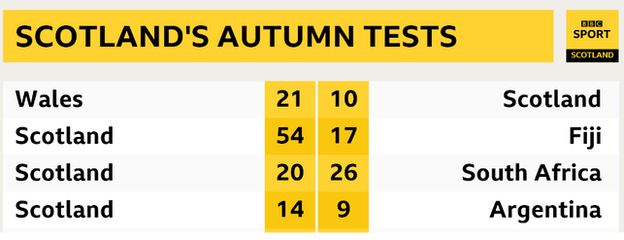Scotland coach Gregor Townsend needs John Barclay back for Six Nations
- Published
Maitland try secures win for Scotland against Argentina
In a rugby year at Murrayfield that brought so much guile and so many thrills, there was a perverse end to it all on Saturday when just about the ugliest home Test of this, and many other years, played out in a dreary afternoon of thud and blunder.
Scotland's win over Argentina was ugly. How ugly? It's hard to capture it, but think Peter Wright in his underpants ugly and you would be on the right lines. No doubt, once he had administered some Wrightian retribution, the great man would concur with that last assessment.
The uncompromising prop-turned-pundit might also say that he is not all that bothered about how Scotland won on Saturday, just as long as they won. And it would be difficult, and probably unwise, to argue with him.
This has been a curious autumn for Scotland. They ended with two wins from four. It could have been four from four and it could have been one from four, however you want to cut it. They lost games against Wales and South Africa that they might have won and won a game against Argentina that they might have lost.
Sam Skinner emerged and he has put himself in the box-seat for major involvement in the Six Nations and beyond.
On Saturday, if there was something vaguely humorous about a Chief (from Exeter) denying a man called Jeronimo (De La Fuente) a near-certain try with only seven minutes left on the clock, then it didn't seem all that funny at the time.
Those were hairy moments for Scotland, but they got through them. Just as a fine margin denied them a win against the Springboks, a fine margin saw them home against the Pumas.
This autumn was supposed to see the arrival of not just Skinner but also Blade Thomson, the Kiwi-Scot transplanted in Llanelli to play for the Scarlets. Thomson has pedigree and, it would seem, a whole lot of class. Scotland's search for back-up in the area of high-energy footballing hard men in the back-row continues because Thomson was invalided out.

Until he steps up to Test level it is difficult to assess him on this stage, but he looks like a player who can stay involved in the action, who can bring his influence to bear, who can do the dirty work up front while also getting round the outside to run and create.
If there was one crying shame of the series, it was that we didn't get a look at Thomson. That will have to wait.
Scotland worship at the altar of quick ruck ball, but didn't get enough of it against Wales, South Africa or Argentina. Their travails in contact is the theme of the moment. They want to play the fastest rugby on the planet and are coming up against teams who are more attuned to their danger than ever before.
Opponents know one of the secrets to stopping Scotland is to check their momentum at the breakdown. That is an issue head coach Gregor Townsend spoke about at length on Saturday. It is one of the big challenges facing him as he heads into the Six Nations and for every minute of every day from now until then he will be praying that injured John Barclay is back in the loop.
Barclay, 32, brings belligerence and nous in the back-row. He brings the breakdown canniness that Scotland have had a lack of at key times against the bigger nations in the autumn. The contact area is king nowadays. For Scotland, it is everything. It is the launch pad for nearly all that is good about them.
The quick-fire attacks that catch teams by surprise - many of them start with quick ruck ball. When it comes to the Six Nations, Scotland need Barclay fit and well every bit as much as they need Finn Russell and Stuart Hogg.

Barclay could only be a spectator at Murrayfield on Saturday
We seem to say it nearly every year, but this Six Nations championship looks like being the most competitive of them all. There is a lot to admire in Scotland and, with three home games at Murrayfield, there are sound reasons to be cheerful about what might happen. The championship, though, is going to be so brutally hard that Townsend's team could win anything from just one game to, possibly, four.
It could be a title bid or a damp squib. The thrill is in not quite knowing which one it is going to be.
As world number two who have just turned over world number one, Ireland, the current champions and Grand Slam winners, are the favourite. They played 12 Tests in 2018 and won 11 of them. They won in Paris, they won at Twickenham, they won a Test series in Australia and then beat New Zealand in Dublin. They have the greatest team, the greatest depth and the greatest coach in their history, Joe Schmidt.
Wales should be considered (only slight) second favourites for they, too, are on an almighty roll. Their victory over South Africa on Saturday was their ninth straight Test win. Wales' depth is tremendous and Ireland have to play them at the Principality Stadium on the final weekend. What a howitzer that could be.
There are growing signs, also, England are beginning to get their act together following autumn victories over South Africa, Australia and a near-miss against New Zealand. France? Who knows? Just when you think that they're beginning to rev up the engine, the machine conks out again.
More than the rest, Ireland and Wales have hardened warriors in all key positions and have more hardened warriors on the bench ready to come on when the starters are carried off on their shields. Up front, their depth is scary. Their respective back-rows contain a legion of leaders and players of enormous toughness and influence.
Ireland can pick three from Peter O'Mahony, Dan Leavy, CJ Stander, Rhys Ruddock, Josh van der Flier, Jordi Murphy, Jack Conan and Sean O'Brien. All have featured in their record-busting 2018.
Wales, in the post-Sam Warburton era, have Justin Tipuric, Dan Lydiate, Ross Moriarty, Adam Shingler, Josh Navidi, Ellis Jenkins (magnificent against South Africa on Saturday but cruelly injured late on), James Davies and Taulupe Faletau. There are one or two others on the periphery as well.
These guys are immensely powerful and clever and instrumental in the success their team has had. Scotland have a shortfall in that area.
Townsend has good players, but how many great ones does he have? There is Barclay and Hamish Watson on the flanks with the highly promising Jamie Ritchie. There is Magnus Bradbury and Matt Fagerson, who in time might become serious players at the top end of the game. There is Ryan Wilson and Dave Denton. There is the unknown quantity of Gary Graham and the optimism surrounding Thomson. Josh Strauss started on Saturday but didn't do his case much good.

On average, Scotland conceded 12.6 turnovers per Test in 2018
Lots of bodies, but how many are in the same category as those they are going up against in the coming months? That is the question. Scotland are improving, but so are the behemoths of the Six Nations.
Scotland have the golden chance of a momentum builder with Italy at home on the first weekend, with Ireland coming to Murrayfield in round two and then a trip to France - who just lost to Fiji in Paris - in round three. As schedules go, that is not half bad. As tournaments go, it is enough to make you giddy.
Scotland can now take a breather (for about 15 seconds) before going again and again and again, all the way through the spring, the summer and back into the autumn and the World Cup.